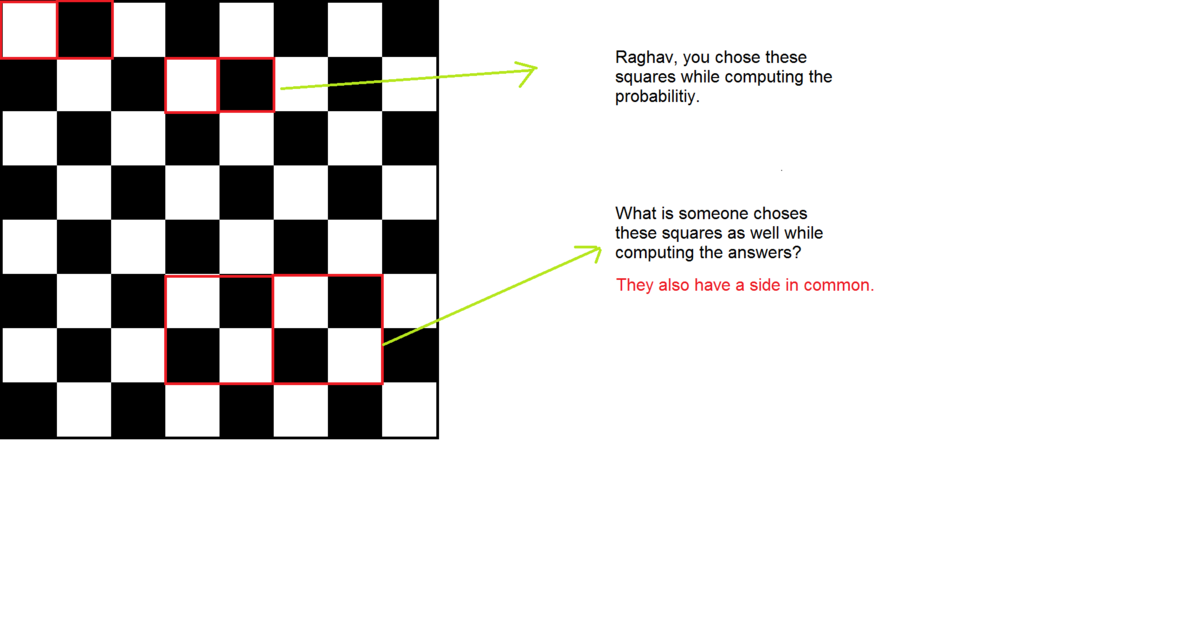Squares of chess
On a chess-board if two squares are chosen, what is the probability that they have side in common.
The answer is 0.055.
This section requires Javascript.
You are seeing this because something didn't load right. We suggest you, (a) try
refreshing the page, (b) enabling javascript if it is disabled on your browser and,
finally, (c)
loading the
non-javascript version of this page
. We're sorry about the hassle.
3 solutions
Replied 0.55 got a wrong answer
Consider all possible cases There are 64C2 ways to select any 2 squares... That is 2016 ways Now looking for favourable cases... Instead of looking for the blocks we count the edges... Every edge signifies the two adjacent blocks connected to it. There are 7 vertical and 7 horizontal lines... Each decided into 8 parts(edges). So we count and get (7x2)x8
So the probability is 112/2016 = 0.0555555.....
Any one with the solution
Adarsh Kumar @Raghav Vaidyanathan
Log in to reply
Total number of ways to select two squares is 6 4 C 2 .
Each side in the chessboard corresponds to a unique pair of squares which have that side common. So just count the number of sides to get the required number of favorable cases. This comes out to be 1 1 2 .
Log in to reply
Next question is: if three squares are chosen at random, what is the probability that there are two (pairwise) "shared" sides? Or in general, if n squares are chosen, what is the probability that there are n − 1 (pairwise) shared sides?
And the NEXT question is: why do I have to keep on thinking of what "the next question" should be? :)
Exactly. : )
You chose the squares of dimensions ( 1 ∗ 1 ) , what if someone chooses squares of ( 2 ∗ 2 ) , i mean they can also have a side in common .

I got a generalization : n 2 C 2 ( n − 1 ) × ( 2 n ) , where n denotes the no of rows/column of a n-sided chessboard.
Sample space will be total ways of selecting 2 squares (order doesn't matter) out of available 64 squares. So sample space = 6 4 C 2
Now there are 7 unique adjacent square sets in each row and each column. i.e. favorable cases will be 7×(8 rows + 8 columns) = 112. Hence Required Probability= S a m p l e S p a c e F a v o u r a b l e c a s e s = 6 4 C 2 1 1 2 = 1 8 1
Also there could be other solution too if we consider ALL possible squares and not only the smallest squares. (i.e. if we consider that total squares are more than 64).
In that case let us first calculate the sample space i.e. total number of squares on a chess board.
1, 8x8 square
4, 7x7 squares
9, 6x6 squares
16, 5x5 squares
25, 4x4 squares
36, 3x3 squares
49, 2x2 squares
64, 1x1 squares
Therefore, there are actually: 6 4 + 4 9 + 3 6 + 2 5 + 1 6 + 9 + 4 + 1 = 8 2 + 7 2 + 6 2 + . . . 1 2 = 2 0 4 squares on a chessboard!
So sample space = 2 0 4 C 2
Now if we assume that 2 squares can have a side common only if they are of the same dimensions:
Let the length of the smallest square be 1 unit.
So the possibility of selecting 2 squares with a common side (As calculated in the first method above):
having the side length greater than 4 unit length = 0
having the side length of 4 unit = 1×(2 rows + 2 columns) = 4
having the side length of 3 unit = 3×(6 rows + 6 columns) = 36
having the side length of 2 unit = 5×(7 rows + 7 columns) = 70
having the side length of 1 unit = 7×(8 rows + 8 columns) = 112
So total number of favorable cases: = 4 + 3 6 + 7 0 + 1 1 2 = 2 2 2
Hence Required Probability= S a m p l e S p a c e F a v o u r a b l e c a s e s = 2 0 4 C 2 2 2 2